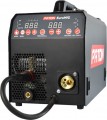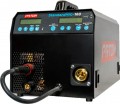Power consumption
Power consumption of the welding machine, expressed in kilovolt-amperes.
kVA is a unit of power used in welding machines along with the more traditional kilowatts. The physical meaning of both units is the same — current multiplied by voltage; however, they denote different parameters. So, in kilowatts, only a part of the total power consumption is recorded — active power (goes to do work and to losses due to heating of individual parts); according to this indicator it is convenient to calculate the practical capabilities of the device. And kilovolt-amperes denote the total energy consumption — it also takes into account reactive power (it goes to losses in coils and capacitors during the operation of alternating current circuits). This data is useful for calculating the total load on the network or other power source.
The apparent power input in kVA will always be greater than the power in kW. However, some manufacturers go to the trick and indicate full power not at full, but at partial (for example, half) load. This gives the impression of efficiency, but is incorrect from a technical point of view. As for the ratio of energy consumption, the active power in kW is often 20-30% lower than the apparent power in kVA. So, in terms of kilovolt-amperes, it is quite possible to evaluate the performance of the unit.
As for specific values, in the most modest models they
do not exceed 3 kVA. An indicator
up to 5 kVA is considered low,
up to 7 kVA — average, and in the most powerful units, the power consumption can reach
10 kVA or even
more.
Max. welding current
The highest current that the welding machine is capable of delivering through the electrodes during operation. In general, the higher this indicator, the thicker the electrodes the device can use and the greater the thickness of the parts with which it can work. Of course, it does not always make sense to chase high currents — they are more likely to damage thin parts. However, if you have to deal with large-scale work and a large thickness of the materials to be welded, you simply cannot do without a device with the appropriate characteristics. Optimum welding currents depending on materials, type of work (see "Type of welding"), type of electrodes, etc. can be specified in special tables. As for specific values, in the most “weak” models, the maximum current
does not even reach 100 A, in the most powerful ones it can exceed
225 A and even
250 A.Max. welding current (duty cycle 100%)
The highest welding current at which the machine is able to operate with a duty cycle of 100%.
See below for more information on the frequency of inclusion (PV). Here we recall that “100% duty cycle” means continuous operation, without shutdowns for cooling. Thus, the maximum welding current at 100% duty cycle is the highest current at which the machine can be used without interruption. Usually, this current is much lower than the maximum.
Duty cycle
The duty cycle allowed for the welding machine.
Almost all modern welding machines require breaks in operation — for cooling and general "recovery". The frequency of inclusion indicates what percentage of the time of the total work cycle can be used directly for work. In this case, 10 minutes is usually taken as a standard cycle. Thus, for example, a device with a duty cycle of
30% will be able to work continuously for less than 3 minutes, after which it will need at least 7 minutes of interruption. However, for some models, a cycle of 5 minutes is used; these nuances should be clarified according to the instructions.
In general, high frequency is required mainly for high-volume professional work; with a relatively simple application, this parameter does not play a decisive role, especially since you have to take breaks during work. As for specific values, the mentioned 30% is a very limited figure, typical mainly for entry-level devices. A value of
30 – 50% is also low; in the range of
50 – 70% is the majority of modern devices, and the most "hardy" models provide a frequency
of more than 70%.
Wire feed speed
Wire feed speed provided by the semi-automatic model (see "Type"). The higher the speed (with the same thickness) — the faster you can lead the electrode over the seam and the less time the process takes. On the other hand, too fast feed makes it difficult to work with seams of small length. Detailed information on the optimal wire feed speed can be found in special sources.
Electrode holder cable
The length of the electrode holder cable supplied with the device.
As the name implies, this cable is used to connect the clamp for the welding electrode to the machine. The longer such a wire is, the more freedom the welder has in moving, the farther he can go without moving the machine itself. On the other hand, excessively long cables create problems in storage and transportation, and often during operation (you need to look for a place where to place the excess wire). Therefore, when choosing, you should proceed from what is more important for you: the ability to move away from the device or the overall compactness. As for specific numbers, most often the length of this wire varies from 2 to 3 m, but in some models it can reach 5 m.
Mass cable
The length of the ground cable supplied with the machine.
The mass cable is a wire that is connected to the workpiece with a clamp. In other words, this is the second contact required to close the circuit during electric welding; connecting such a wire actually turns the workpiece into one solid fixed electrode (paired with a movable welding electrode). As for the length of such a wire, the longer it is, the farther from the connection point you can place the machine and the more freedom of movement the welder gets. On the other hand, excessively long wires create problems in storage and transportation, and often during work (you need to look for a place where to place the excess cable). In addition, freedom of movement can be ensured by increasing the length of the second wire — for the electrode holder or burner. Thus, the mass cable in modern welding machines usually has a length of 1.2 to 3 m (with some exceptions — both smaller and larger). This length allows you to comfortably place the device and at the same time does not create problems.
Torch cable
The length of the torch cable supplied with the machine.
The term "torch" is relevant for welding such as TIG (in argon, non-consumable electrode) or MIG / MAG (partially automated welding in an inert (MIG) or active (MAG) gas) - this is what the working nozzle for such welding is called. And the longer the wire with which the burner is connected to the device, the more freedom the welder has in moving, the farther he can go without moving the device itself. On the other hand, excessively long cables create problems in storage and transportation, and often during operation (you need to look for a place where to place the excess wire). Therefore, when choosing, you should proceed from what is more important for you: the ability to move away from the device or the overall compactness. As for specific length options, they usually range from 2 to 5 meters.

